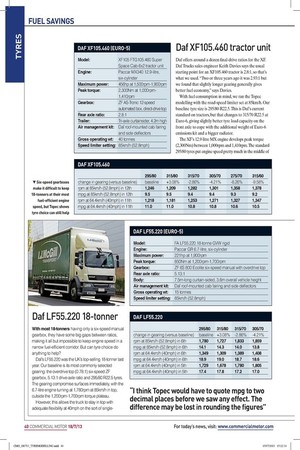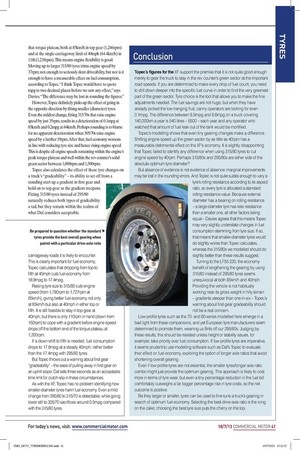Daf XF105.460 tractor unit Daf offers around a dozen final-drive
Page 32

Page 33

If you've noticed an error in this article please click here to report it so we can fix it.
ratios for the XF. Daf Trucks sales engineer Keith Davies says the usual starting point for an XF105.460 tractor is 2.8:1, so that's what we used. "Two or three years ago it was 2.93:1 but we found that slightly longer gearing generally gives better fuel economy," says Davies.
With fuel consumption in mind, we ran the Topec modelling with the road-speed limiter set at 85km/h. Our baseline tyre size is 295/80 R22.5. This is Daf's current standard on tractors, but that changes to 315/70 R22.5 at Euro-6, giving slightly better tyre load capacity on the front axle to cope with the additional weight of Euro-6 emissions kit and a bigger radiator.
The XF's 12.9-litre MX engine develops peak torque (2,300Nm) between 1,000rpm and 1,410rpm.The standard 295/80 tyres put engine speed pretty much in the middle of that torque plateau, both at 85km/h in top gear (1,246rpm) and at the single-carriageway limit of 40mph (64.4km/h) in 11th (1,218rpm). This means engine flexibility is good. Moving up to larger 315/80 tyres trims engine speed by 37rpm; not enough to seriously dent driveability, but nor is it enough to have a measurable effect on fuel consumption, according to Topec. "I think Topec would have to quote mpg to two decimal places before we saw any effect," says Davies. "The difference may be lost in rounding the figures."
However, Topec definitely picks up the effect of going in the opposite direction by fitting smaller (diameter) tyres. Even the mildest change, fitting 315/70s that raise engine speed by just 35rpm, results in a deterioration of 0.1mpg at 85km/h and 0.2mpg at 64km/h. Perhaps rounding is to blame for no apparent deterioration when 305/70s raise engine speed by a further 19rpm. After that, fuel economy worsens in line with reducing tyre size and hence rising engine speed. This is despite all engine speeds remaining within the engine's peak torque plateau and well within the rev counter's solid green sector between 1,000rpm and 1,500rpm.
Topec also calculates the effect of these tyre changes on a truck's "gradeability" — its ability to set off from a standing start up a gradient in first gear and hold on to top gear as the gradient steepens. Fitting 315/80 tyres instead of 295/80 naturally reduces both types of gradeability a tad, but they remain within the realms of what Daf considers acceptable.








































